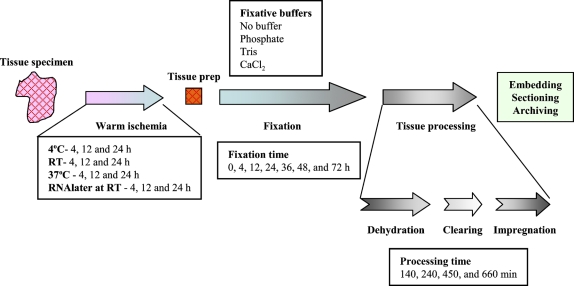Figure 1.
Diagram of the pathway a tissue specimen takes from removal from patient to an archival tissue block. After devitalization of the specimen, there is a variable length of time before the specimen is placed in fixative. During this period, called “warm ischemia,” the tissue lacks oxygen and anoxic metabolic pathways take over. The specimen undergoes some form of preparation before fixation, depending on the size and complexity of the specimen. The specimen fixes, optimally in 10 volumes of fixative for a duration suitable for complete penetration of the fixative (1 mm/hr). After fixation, the specimen undergoes “tissue processing” on an automated instrument that serially replaces the fluids within a retort to accomplish the replacement of water with paraffin. This three-step process (dehydration, clearing, and impregnation) is accomplished with a variable number of steps (12–14), with more steps devoted to dehydration than clearing or impregnation. Some steps may contain the same reagent, in an effort to complete the exchange of solvents. Most tissue processors operate under vacuum. After tissue processing, the specimen is “embedded” (surrounded with paraffin that acts as a solid support for microtomy). Conditions examined in this study are summarized within the text boxes. For the experiments in this study, the variables were studied in isolation. For experiments on warm ischemia, RNA was assayed before fixation and processing. In all experiments on fixation and tissue processing, warm ischemia was minimized, with a maximum duration of 15 min. For the experiments on fixation, tissue was processed, fixed in phosphate-buffered formalin, and processed at 30 min/step. For experiments on fixative buffer, fixation time was fixed at 24 hr, and tissue was processed for 30 min/step. For experiments on tissue processing, tissue was fixed for 24 hr in phosphate-buffered formalin.

